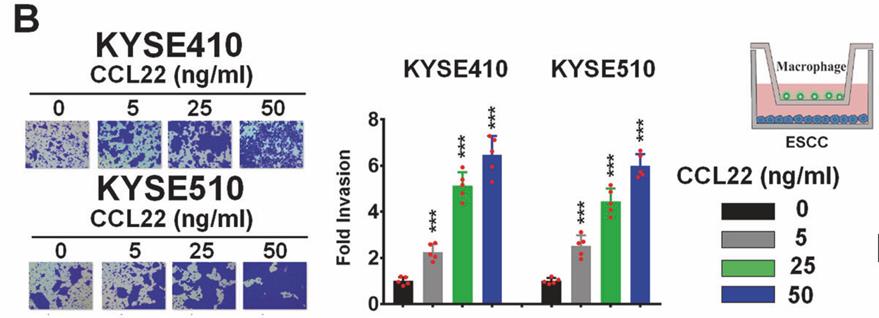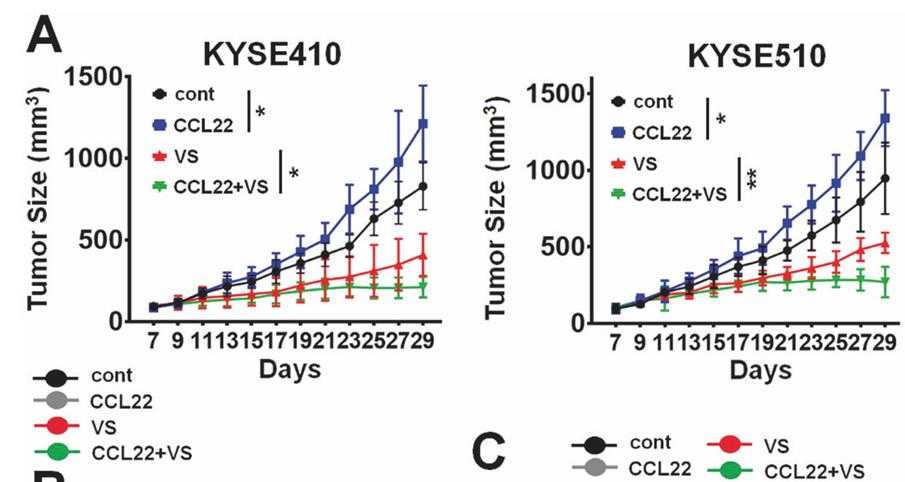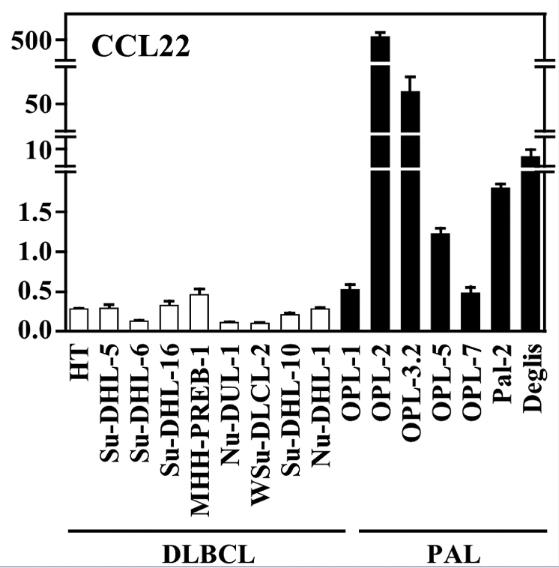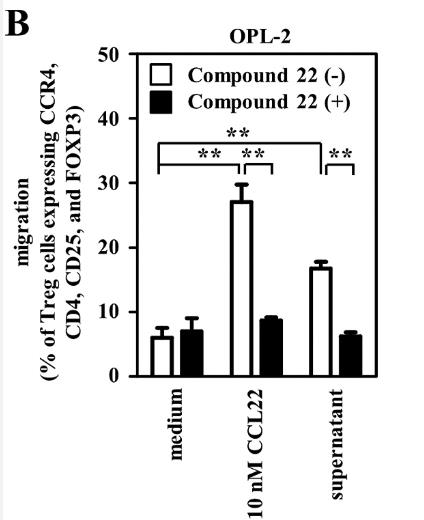CCL22
-
Official Full Name
CCL22 chemokine (C-C motif) ligand 22 -
Overview
This gene is one of several Cys-Cys (CC) cytokine genes clustered on the q arm of chromosome 16. Cytokines are a family of secreted proteins involved in immunoregulatory and inflammatory processes. The CC cytokines are proteins characterized by two adjacent cysteines. The cytokine encoded by this gene displays chemotactic activity for monocytes, dendritic cells, natural killer cells and for chronically activated T lymphocytes. It also displays a mild activity for primary activated T lymphocytes and has no chemoattractant activity for neutrophils, eosinophils and resting T lymphocytes. The product of this gene binds to chemokine receptor CCR4. This chemokine may play a role in the trafficking of activated T lymphocytes to inflammatory sites and other aspects of activated T lymphocyte physiology. -
Synonyms
CCL22;chemokine (C-C motif) ligand 22;MDC;ABCD-1;SCYA22;STCP-1;DC/B-CK;MGC34554;A-152E5.1;C-C motif chemokine 22;MDC(1-69);OTTHUMP00000164658;CC chemokine STCP-1;macrophage-derived chemokine;small inducible cytokine A22;small-inducible cytokine A22;stimulated T cell chemotactic protein 1;stimulated T-cell chemotactic protein 1;small inducible cytokine subfamily A (Cys-Cys), member 22
Recombinant Proteins
- Mouse
- Human
- Rat
- Cattle
- Dog
- Pig
- CHO
- Wheat Germ
- E.coli
- HEK293
- Human Cells
- In Vitro Cell Free System
- Fc
- GST
- His
- Non
- DDK
- Myc
- rFc
Background
What is CCL22 protein?
CCL22 gene (C-C motif chemokine ligand 22) is a protein coding gene which situated on the long arm of chromosome 16 at locus 16q21. This antimicrobial gene is one of several Cys-Cys (CC) cytokine genes clustered on the q arm of chromosome 16. Cytokines are a family of secreted proteins involved in immunoregulatory and inflammatory processes. The CC cytokines are proteins characterized by two adjacent cysteines. The cytokine encoded by this gene displays chemotactic activity for monocytes, dendritic cells, natural killer cells and for chronically activated T lymphocytes. It also displays a mild activity for primary activated T lymphocytes and has no chemoattractant activity for neutrophils, eosinophils and resting T lymphocytes. The CCL22 protein is consisted of 93 amino acids and CCL22 molecular weight is approximately 10.6 kDa.
What is the function of CCL22 protein?
The functions of CCL22 are very diverse, and it plays an important role in signaling in the tumor environment. It is involved in the regulation of T cell immunity, both by recruiting Tregs to tumor tissue and by promoting dendritic cell contact with Tregs in lymph nodes. In addition, CCL22 also plays a role in maintaining immune homeostasis and promoting the clearance of apoptotic cells. In lymphoid organs, the expression of CCL22 is aided by T cells, and in particular, T-cell-derived GM-CSF is the main inducer of CCL22 production by dendritic cells. The expression of CCL22 is also regulated by the transcription factor PU.1, which is highly expressed in DCs and macrophages and can directly bind to the promoter region of CCL22 gene through two Ets motifs, thereby activating CCL22 expression.
CCL22 Related Signaling Pathway
CCL22 has chemotactic activity on monocytes, dendritic cells, and natural killer cells, and is a mild chemokine on first activated T cells, and a potent chemokine on long-activated T cells, but has no chemotactic activity on neutrophils, eosinophils, and dormant T cells. CCL22 is associated with a variety of signaling pathways, including but not limited to:
Akt signaling pathway: involved in cell survival and proliferation.
All-trans retinoic acid signaling pathways in the brain: involved in nervous system development and function.
Antioxidant effects of vitamin C: involvement in cellular oxidative stress.
Chemokine signaling pathway: involved in cell migration and localization.
Endothelin-1 signaling pathway: associated with vascular function and blood pressure regulation.
CCL22 Related Diseases
As an important chemokine, CCL22 plays a key role in the occurrence and development of many diseases. By binding to the receptor CCR4, it affects the migration and function of regulatory T cells (Tregs), which in turn participate in the pathological processes of allergic inflammatory diseases such as atopic dermatitis and asthma. In addition, CCL22 also plays a role in autoimmune diseases, such as rheumatoid arthritis and systemic lupus erythematosus, where it may play an immunosuppressive role by promoting the directed migration of Tregs cells to sites of inflammation. In the tumor microenvironment, CCL22 is involved in tumor immune escape by recruiting Tregs cells, and is closely related to the prognosis of various malignant tumors, such as adult T-cell leukemia/lymphoma, breast cancer, lung cancer, and gastric cancer.

Fig1. Mechanisms of CCL22 induction in cancer. (Natascha Röhrle, 2020)
Bioapplications of CCL22
In oncology, CCL22 is seen as a potential target for cancer immunotherapy due to its ability to recruit regulatory T cells in the tumor microenvironment, contributing to the development of novel therapeutic strategies such as inhibiting tumor immune escape by blocking the CCL22-CCR4 axis. In addition, the active expression of CCL22 in allergic diseases and autoimmune diseases has also made it a hot spot for drug development, such as regulating the immune response through CCR4 inhibitors, which have shown efficacy in conditions such as atopic dermatitis. These applications include not only the direct intervention of the CCL22 signaling pathway, but also the regulation of the immune cell behavior affected by it, providing new perspectives and methods for the treatment of related diseases.
Case Study
Case Study 1: Jie Chen, 2022
Tumor cell dependence on activated oncogenes is considered a therapeutic target, but protumorigenic microenvironment-mediated cellular addiction to specific oncogenic signaling molecules remains to be further defined. Here, researchers showed that tumor-associated macrophages (TAMs) produced an abundance of C-C motif chemokine 22 (CCL22), whose expression in the tumor stroma was positively associated with the level of intratumoral phospho-focal adhesion kinase (pFAK Tyr397), tumor metastasis and reduced patient survival. Functionally, CCL22-stimulated hyperactivation of FAK was correlated with increased malignant progression of cancer cells. Mechanistically, researchers identified that diacylglycerol kinase α (DGKα) acted as a signaling adaptor to link the CCL22 receptor C-C motif chemokine receptor 4 (CCR4) and FAK and promoted CCL22-induced activation of the FAK/AKT pathway. CCL22/CCR4 signaling activated the intracellular Ca2+/phospholipase C-γ1 (PLC-γ1) axis to stimulate the phosphorylation of DGKα at a tyrosine residue (Tyr335) and promoted the translocation of DGKα to the plasma membrane to assemble the DGKα/FAK signalosome, which critically contributed to regulating sensitivity to FAK inhibitors in cancer cells.

Fig1. Boyden chamber assay of the indicated ESCC cells, with culture medium containing rCCL22.

Fig2. Tumor growth curves are shown after injected along with rCCL22.
Case Study 2: Tomonori Higuchi, 2019
Epstein-Barr virus (EBV)-positive diffuse large B-cell lymphomas associated with chronic inflammation (DLBCL-CI) develop in patients with chronic inflammation but without any predisposing immunodeficiency. Given the expression of the EBV latent genes, DLBCL-CI should have mechanisms for evasion of host antitumor immunity. EBV-positive pyothorax-associated lymphoma (PAL) is a prototype of DLBCL-CI and may provide a valuable model for the study of immune evasion by DLBCL-CI. This study demonstrates that PAL cell lines express and secrete CCL17 and/or CCL22 chemokines, the ligands of C-C motif chemokine receptor 4 (CCR4), in contrast to EBV-negative DLBCL cell lines. Accordingly, culture supernatants of PAL cell lines efficiently attracted CCR4-positive regulatory T (Treg) cells in human peripheral blood mononuclear cells.

Fig3. Concentrations of CCL17 and CCL22 in the culture supernatants were measured by ELISA.

Fig4. Human peripheral blood mononuclear cells were examined for cell migration and Recombinant CCL22 was used as positive control.
Quality Guarantee
High Purity
.jpg)
Fig1. SDS-PAGE (CCL22-67H)
.
.jpg)
Fig2. SDS-PAGE (CCL22-702H)
Involved Pathway
CCL22 involved in several pathways and played different roles in them. We selected most pathways CCL22 participated on our site, such as Cytokine-cytokine receptor interaction,Chemokine signaling pathway, which may be useful for your reference. Also, other proteins which involved in the same pathway with CCL22 were listed below. Creative BioMart supplied nearly all the proteins listed, you can search them on our site.
| Pathway Name | Pathway Related Protein |
|---|---|
| Chemokine signaling pathway | MAP2K1,Ccl21c,CX3CR1,GM1987,WASL,CCL26,GNG4,RAC1,PIK3CB,CXCL13 |
| Cytokine-cytokine receptor interaction | OSTN,IL13RA1,KITLGA,TNFRSF10B,OSM,TP-1,ACVR1,TNFRSF13B,TNFRSF9,CXCR3.1 |
Protein Function
CCL22 has several biochemical functions, for example, CCR chemokine receptor binding,chemokine activity. Some of the functions are cooperated with other proteins, some of the functions could acted by CCL22 itself. We selected most functions CCL22 had, and list some proteins which have the same functions with CCL22. You can find most of the proteins on our site.
| Function | Related Protein |
|---|---|
| CCR chemokine receptor binding | CCL44,CXCL32B.1,CCL26,CCL34B.4,CCL34B.1,CCL33.3,CCL15,CCL11,CCL20A.3,CCL38A.5 |
| chemokine activity | CX3CL1,CCL35.2,CCL25B,CXCL1,CXCL32B.1,CCL33.3,CCL34B.4,CCL3L3,CXCL13,CCL1 |
Interacting Protein
CCL22 has direct interactions with proteins and molecules. Those interactions were detected by several methods such as yeast two hybrid, co-IP, pull-down and so on. We selected proteins and molecules interacted with CCL22 here. Most of them are supplied by our site. Hope this information will be useful for your research of CCL22.
DPP4;CRYAB;GCLC;HERC3
Resources
Gene Families
Research Area
Related Services
Related Products
References
- Yoshie, O; Matsushima, K; et al. CCR4 and its ligands: from bench to bedside. INTERNATIONAL IMMUNOLOGY 27:11-20(2015).
- Hernandez-Bedolla, MA; Carretero-Ortega, J; et al. Chemotactic and proangiogenic role of calcium sensing receptor is linked to secretion of multiple cytokines and growth factors in breast cancer MDA-MB-231 cells. BIOCHIMICA ET BIOPHYSICA ACTA-MOLECULAR CELL RESEARCH 1853:166-182(2015).




